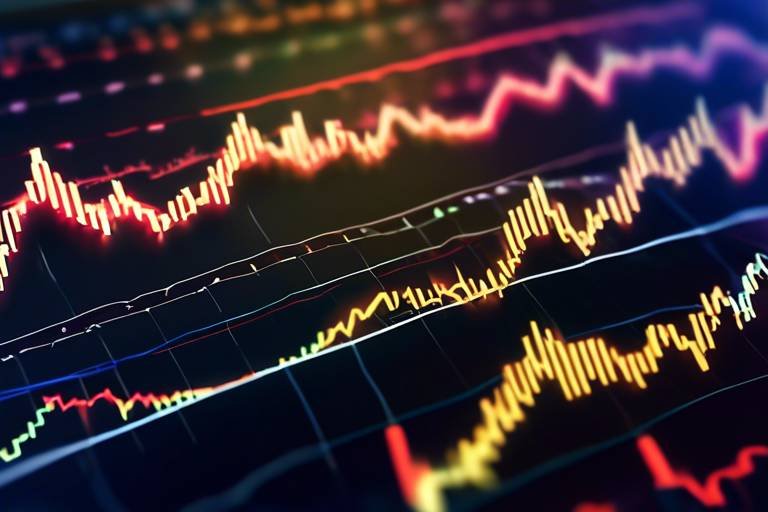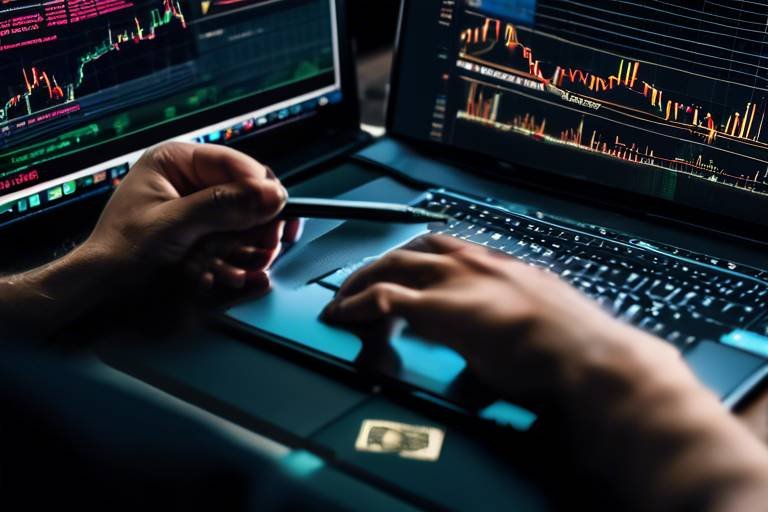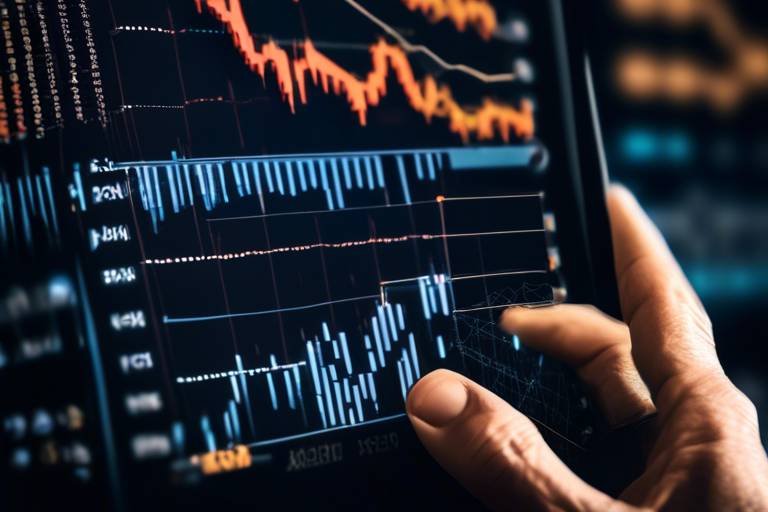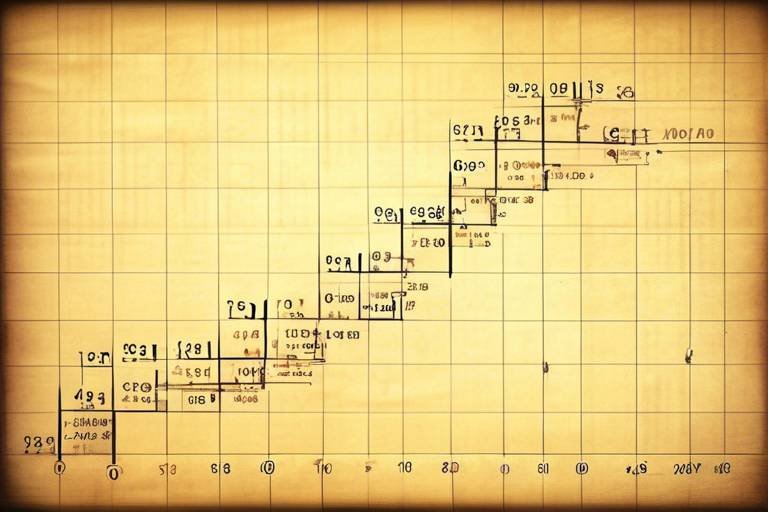How to Interpret Volume Trends in Cryptocurrency Markets
In the fast-paced world of cryptocurrency trading, understanding how to interpret volume trends can be your secret weapon. Volume, simply put, refers to the number of coins that are traded over a specific period. It’s not just a number; it’s a pulse of the market. When you see high trading volume, it often indicates a strong interest in a particular asset, while low volume can hint at stagnation or even manipulation. Imagine volume as the roar of a crowd at a concert—if the crowd is loud, the energy is high, and the show is a hit. Conversely, a whispering crowd might signal that something is off. So, let’s dive into the significance of volume trends and how you can leverage them to make informed investment decisions.
Understanding why volume matters in cryptocurrency trading is crucial for anyone looking to navigate this volatile landscape. High trading volume often indicates strong market interest, which can lead to price movements that are both upward and downward. Think of it as a barometer for market sentiment. When traders are excited about a coin, they buy in droves, pushing the price up. On the flip side, if the volume is low, it might mean that traders are hesitant or that there’s a lack of confidence in the asset. This can often lead to stagnation or even a price drop. Therefore, keeping an eye on volume can save you from making hasty decisions that could cost you dearly.
Recognizing different volume patterns can help traders predict market movements more effectively. Just like reading the waves at a beach, understanding volume trends can give you insight into what’s coming next. Common patterns include spikes, drops, and consistent trends. For instance, a sudden spike in volume could indicate that something significant is happening in the market, perhaps due to a news event or a major trade. Conversely, a steady decline in volume might suggest that traders are losing interest, which could precede a price drop. By familiarizing yourself with these patterns, you can better position yourself to capitalize on market movements.
Volume spikes can indicate sudden interest or panic in the market. These spikes are like fireworks; they grab your attention and often signal something important. Analyzing these spikes helps traders understand potential price reversals or continuations. For example, if you see a significant spike in volume accompanied by a price increase, it might suggest a breakout, signaling that it’s time to buy. However, if the volume spikes without a corresponding price movement, it could indicate manipulation or a false signal, which is why context is key.
Various factors can lead to volume spikes, including:
- News events that create excitement or panic.
- Shifts in market sentiment due to social media buzz.
- Large trades executed by institutional investors.
Understanding these causes is essential for effective trading strategies. By keeping an ear to the ground and staying informed about market developments, you can better anticipate when these spikes might occur and adjust your trading strategy accordingly.
Interpreting volume spikes requires context and a keen eye for detail. A spike accompanied by a significant price movement may suggest a genuine breakout, whereas a spike without any price change could indicate manipulation or a lack of follow-through. This is where your analytical skills come into play. Always look for additional confirmation before making a trading decision based solely on volume spikes.
Analyzing volume trends over time is like looking at a long-term weather forecast. It helps traders identify long-term market behaviors. Consistent volume growth often correlates with bullish trends, while declining volume may indicate bearish conditions. By examining historical volume data, you can gain insights into how a particular cryptocurrency has performed over time and use that information to inform your future trading decisions.
Volume indicators, such as the On-Balance Volume (OBV) and Volume Moving Average, provide valuable insights into market strength. These tools assist traders in making data-driven decisions. For instance, the OBV indicator measures buying and selling pressure, helping traders gauge market momentum and potential price changes. Similarly, the Volume Moving Average smooths out volume data, allowing for clearer trend identification.
The OBV is a popular volume indicator that helps traders understand the relationship between volume and price. By analyzing OBV trends, you can gauge market momentum and identify potential price changes. If the OBV is rising while the price is stagnant, it could indicate that buying pressure is building, which may lead to a price increase in the near future.
The Volume Moving Average is another useful tool that smooths out volume data, making it easier to identify trends. This indicator can signal potential entry and exit points in the market. For example, if the current volume exceeds the moving average, it may suggest a bullish trend, prompting traders to consider buying.
Integrating volume analysis with price action enhances trading strategies significantly. Observing how volume correlates with price movements can provide deeper insights into market dynamics. For instance, high volume at support or resistance levels can confirm these critical points, indicating strong buying or selling pressure. This combination of volume and price analysis can help you make more informed decisions in your trading journey.
Volume often plays a crucial role in confirming support and resistance levels. High volume at these levels can indicate strong buying or selling pressure. If the price approaches a resistance level with increasing volume, it might suggest that a breakout is imminent. Conversely, if the price hits a support level with high volume, it could indicate that the level will hold.
Volume divergence occurs when price trends differ from volume trends. Identifying these divergences can signal potential reversals, making them important for traders to watch. For example, if the price is rising but volume is declining, it may indicate a weakening trend and a potential reversal could be on the horizon.
Many misconceptions surround volume analysis, and understanding what volume truly indicates can help traders avoid pitfalls. For instance, while high volume often suggests liquidity, it doesn't guarantee it. Traders should be cautious, as high volume can sometimes be misleading, especially in illiquid markets. Another common misconception is that volume can be used as a sole indicator for trading decisions. Relying solely on volume can lead to poor trading outcomes. It's essential to use volume in conjunction with other indicators for a comprehensive market analysis.
What is the significance of volume in cryptocurrency trading?
Volume helps gauge market interest and can indicate potential price movements. High volume often signals strong buying or selling pressure.
How can I identify volume spikes?
Volume spikes can be identified by observing sudden increases in trading volume, often accompanied by significant price movements.
Should I rely solely on volume for trading decisions?
No, it's important to use volume in conjunction with other indicators for a well-rounded analysis.
What are some common volume indicators?
Popular volume indicators include On-Balance Volume (OBV) and Volume Moving Average, which help traders analyze market strength.

The Importance of Volume in Cryptocurrency
When diving into the world of cryptocurrency, one of the first things you’ll hear about is the term volume. But what does it really mean, and why is it so crucial? In simple terms, volume refers to the total number of coins traded within a specific timeframe. Think of it as the heartbeat of the market—when the volume is high, you can feel the pulse of activity, excitement, and potential price movements. Conversely, low volume can signify a market that’s stagnant or, worse, being manipulated by a few players.
Understanding why volume matters in cryptocurrency trading is key for any investor looking to make informed decisions. High trading volume often indicates strong market interest and can suggest that a trend is likely to continue. For example, imagine a concert where the crowd is roaring with excitement; this high energy often translates to a successful show. Similarly, in the crypto market, high volume can mean that investors are confident, pushing prices higher.
On the flip side, low trading volume can be a red flag. It often indicates a lack of interest, which can lead to price stagnation or even manipulation. Picture a movie that no one wants to see; it’s likely to leave the box office in the dust. In crypto terms, when volume is low, it could mean that a few large traders are pulling the strings, making it difficult for the average investor to gauge true market sentiment.
Moreover, volume can also provide insights into potential price reversals. For instance, if you notice a sudden spike in volume while the price is trending downward, it could signal that buyers are stepping in, possibly reversing the trend. Conversely, if the price is rising but volume is decreasing, it might suggest that the upward movement lacks strength and could soon falter.
To summarize, volume is not just a number; it’s a vital indicator that can help traders and investors alike gauge market health. Whether you're looking to enter a new position or exit an existing one, paying attention to volume trends can significantly enhance your trading strategy. So, the next time you're analyzing a cryptocurrency, remember to check its volume—it's like having a secret weapon in your trading arsenal!

Identifying Volume Patterns
When diving into the world of cryptocurrency trading, one of the most enlightening aspects is learning to identify volume patterns. These patterns serve as a window into the market's soul, revealing the emotions and intentions of traders. Just like reading a book, understanding these patterns can help you anticipate the plot twists that the market may throw your way. So, what do these patterns look like, and why should you care? Let's break it down.
Volume patterns can be categorized into several types, each telling a different story about market sentiment. For instance, a volume spike often signals a sudden surge of interest, whether from excitement or panic. Conversely, a volume drop may indicate a lack of interest or a potential downturn. Recognizing these patterns is crucial because they can provide valuable insights into future price movements. Think of it as a traffic light for traders; green means go, while red warns you to stop and reassess.
One common pattern traders look for is the consistent volume trend. When volume steadily increases over time, it usually indicates a growing interest in a particular asset. This can be a strong signal of a bullish trend, suggesting that more buyers are entering the market. On the flip side, if you notice a consistent decline in volume, it's a red flag that the market might be losing momentum, which could lead to bearish conditions. In this sense, volume acts like the heartbeat of the market, and understanding its rhythm can help you make informed trading decisions.
Another important aspect of volume patterns is their relationship with price movements. For example, if you observe a significant price increase accompanied by a corresponding increase in volume, it typically suggests that the price movement is backed by strong market support. Conversely, if the price rises but volume remains stagnant, it may indicate a lack of genuine interest, hinting at a potential reversal. In essence, volume serves as a confirmation tool, validating price movements and helping traders gauge whether they are on the right track.
To sum it up, identifying volume patterns is not just about crunching numbers; it's about understanding the underlying psychology of the market. By paying attention to these patterns, traders can better navigate the tumultuous waters of cryptocurrency trading. Whether you're a seasoned trader or just starting, mastering volume patterns will undoubtedly enhance your trading strategy and help you make more informed decisions.
- What is a volume spike? A volume spike refers to a sudden increase in trading volume, which can indicate heightened interest or panic in the market.
- How can I identify volume patterns? By analyzing historical volume data alongside price movements, you can spot trends and patterns that may signal future market behavior.
- Why is volume important in trading? Volume is crucial because it reflects the level of interest in an asset, helping traders gauge market sentiment and potential price movements.

Volume Spikes and Their Implications
When it comes to the world of cryptocurrency trading, volume spikes can be a trader's best friend or worst enemy. These sudden increases in trading volume often signal significant market activity and can lead to pivotal price movements. Imagine you're at a concert, and the crowd suddenly erupts with excitement; that's what a volume spike feels like in the trading world. It indicates that something noteworthy is happening, and traders need to pay attention.
Understanding the implications of these spikes is crucial. A volume spike can indicate a variety of scenarios:
- Increased Interest: A sudden surge in volume often suggests that traders are flocking to a particular asset, which can lead to a price increase.
- Panic Selling: Conversely, a spike in volume can also indicate panic selling, where traders rush to exit their positions, leading to a potential price drop.
- Market Manipulation: Sometimes, a spike without a corresponding price change can suggest manipulation, where large players are trying to influence the market.
To effectively interpret these spikes, context is key. For instance, if a volume spike occurs alongside a significant price movement, it may suggest a breakout or a strong trend. On the other hand, if the volume spikes but the price remains stagnant, it could indicate that the market is being manipulated or that traders are simply reacting to news without a clear direction.
So, how do traders navigate these waters? By analyzing the causes of volume spikes. Factors such as major news events, regulatory announcements, or even social media trends can trigger these spikes. For example, if a well-known influencer tweets about a specific cryptocurrency, it can lead to a massive influx of traders, resulting in a volume spike.
Additionally, traders should be aware of the duration of these spikes. A brief spike might not hold the same weight as a prolonged increase in volume. To illustrate, consider the following table that summarizes the implications based on the duration and price movement associated with volume spikes:
| Duration of Spike | Price Movement | Implication |
|---|---|---|
| Short-term | Significant Increase | Potential Breakout |
| Short-term | No Change | Possible Manipulation |
| Long-term | Consistent Increase | Strong Bullish Trend |
| Long-term | Consistent Decrease | Bearish Sentiment |
In conclusion, recognizing and interpreting volume spikes can significantly enhance a trader's ability to make informed decisions. By paying attention to the context, duration, and associated price movements, traders can better navigate the often tumultuous waters of cryptocurrency trading.

Causes of Volume Spikes
Volume spikes in cryptocurrency markets can be attributed to a variety of factors that stir the pot of trading activity. One of the primary causes is significant news events. When a major announcement is made—like a regulatory change, a partnership, or a technological advancement—traders rush to buy or sell, leading to an abrupt increase in volume. This can create a ripple effect, as news spreads across social media and trading platforms, further amplifying the surge.
Another common cause is market sentiment shifts. For instance, if traders collectively feel optimistic about a particular cryptocurrency due to positive market trends, you can expect a spike in buying activity. Conversely, negative sentiment—perhaps triggered by a security breach or unfavorable market conditions—can lead to panic selling, again resulting in a spike.
Additionally, large trades by institutional investors or “whales” can significantly impact trading volume. When these entities make substantial purchases or sales, it often triggers a chain reaction among smaller traders who either follow suit or react defensively, causing a notable increase in volume. This phenomenon is particularly evident during market open and close times, where liquidity can be lower, making the impact of large trades even more pronounced.
Lastly, market manipulation can also cause volume spikes. In some cases, traders may engage in practices like wash trading, where they buy and sell the same asset to create the illusion of high trading volume. This can mislead other traders into thinking there is genuine market interest, prompting them to act based on false signals. It's crucial for traders to remain vigilant and analyze the context of volume spikes to distinguish between genuine interest and potential manipulation.
- What is a volume spike? A volume spike refers to a sudden increase in trading activity for a particular cryptocurrency, often indicating heightened interest or panic among traders.
- How can I identify a volume spike? Traders can identify volume spikes by monitoring trading volume charts and looking for significant deviations from average volume levels.
- Are volume spikes always a good sign? Not necessarily. While they can indicate strong market interest, they can also result from manipulation or panic selling, so context is crucial.
- How should I react to a volume spike? It's important to analyze the underlying reasons for the spike. Assess market news, sentiment, and price movements before making trading decisions.

Interpreting Volume Spikes
When it comes to interpreting volume spikes, context is everything. A sudden surge in trading volume can often be a double-edged sword, revealing both opportunities and potential pitfalls for traders. Imagine standing at the edge of a cliff, where a gust of wind could either lift you higher or send you tumbling down. In the world of cryptocurrency, a volume spike can signify a variety of scenarios, and understanding these nuances is key to making informed trading decisions.
Firstly, it's essential to consider what accompanies the volume spike. For instance, if a spike occurs alongside a significant price movement, it may suggest a breakout or a strong continuation of a trend. This scenario often indicates that numerous traders are entering the market, either buying or selling, which can lead to a sustained price movement. Conversely, if the volume spikes but the price remains stagnant, it could be a sign of manipulation or a lack of genuine interest, where a few large players are influencing the market without real support from the broader trading community.
To illustrate this concept, let’s break down the implications of volume spikes into a simple table:
| Scenario | Implication |
|---|---|
| Volume Spike + Price Increase | Potential breakout; strong market interest |
| Volume Spike + Price Decrease | Possible panic selling; caution advised |
| Volume Spike + No Price Change | Possible market manipulation; investigate further |
Moreover, it’s crucial to analyze the duration of the volume spike. A brief spike that quickly returns to normal levels might not have the same impact as a sustained increase in volume over several days. This sustained volume can indicate that a new trend is forming, and traders should be prepared to adjust their strategies accordingly. Think of it like a wave in the ocean; a sudden splash may catch your attention, but it’s the consistent rise and fall of the tide that truly shapes the shoreline.
Lastly, always remember to consider external factors that may contribute to volume spikes. News events, regulatory announcements, or even social media trends can trigger sudden interest in a cryptocurrency, leading to spikes. By staying informed and analyzing the broader market context, traders can better interpret these volume spikes and make decisions that align with their trading strategies.

Volume Trends Over Time
When diving into the world of cryptocurrency trading, one of the most insightful aspects to explore is the trends in trading volume over time. Analyzing these trends can provide a clearer picture of market dynamics and help traders make better-informed decisions. Just like a seasoned sailor reads the winds, traders can read volume trends to navigate the often-turbulent seas of the crypto market.
To grasp the significance of volume trends, consider this: consistent volume growth often correlates with bullish market conditions. This means that as more traders enter the market, pushing the volume higher, it can signal a rising interest in a particular cryptocurrency, potentially leading to price increases. Conversely, a decline in volume can indicate bearish conditions, where interest wanes, and prices may stagnate or fall. This relationship between volume and price is crucial, as it can help traders anticipate market movements.
One effective way to visualize these trends is through a volume chart. This chart can display volume alongside price movements, allowing traders to identify patterns more easily. For instance, if a cryptocurrency has been experiencing a steady increase in volume while its price is also rising, it could suggest a strong bullish trend. On the other hand, if the price is rising but the volume is decreasing, it might indicate a lack of conviction in the price movement, raising a red flag for traders.
To further illustrate this point, consider the following table that outlines hypothetical volume trends for a cryptocurrency over a month:
| Date | Price ($) | Volume (BTC) |
|---|---|---|
| Day 1 | 100 | 500 |
| Day 10 | 120 | 700 |
| Day 15 | 150 | 900 |
| Day 20 | 140 | 400 |
| Day 30 | 130 | 300 |
In this example, you can see how the volume fluctuates in relation to price changes. Notice how the volume increases significantly as the price rises to $150, but then drops sharply while the price decreases to $140. This could signal a potential reversal or a lack of interest in maintaining that price level. Understanding these trends is vital for traders looking to capitalize on market movements.
Moreover, traders should also be aware of the importance of timeframes when analyzing volume trends. Short-term fluctuations might indicate temporary market sentiments, while long-term trends can reveal more stable patterns. For instance, a trader might observe a consistent increase in volume over several months and use that information to build a bullish position, while another trader may focus on daily volume spikes to make quick trades.
In summary, volume trends over time are a powerful tool in the arsenal of any cryptocurrency trader. By carefully analyzing these trends, traders can gain insights into market sentiment and make more informed decisions. Whether you're a day trader looking for quick profits or a long-term investor aiming to ride the waves of market growth, understanding volume trends is essential for navigating the ever-changing landscape of cryptocurrency trading.
- What is trading volume in cryptocurrency?
Trading volume refers to the total amount of a cryptocurrency that has been traded in a specific period. It reflects the level of activity and interest in that cryptocurrency within the market.
- How can I analyze volume trends?
You can analyze volume trends by observing volume charts, using volume indicators, and comparing volume with price movements over various timeframes.
- Why is volume important in trading?
Volume is important because it indicates market interest and liquidity. High volume can suggest strong price movements, while low volume may indicate stagnation or manipulation.

Using Volume Indicators
When diving into the world of cryptocurrency trading, understanding volume indicators is like having a compass in a dense forest. These indicators help traders navigate through the chaotic market landscape by providing essential insights into the strength of price movements. By analyzing volume alongside price action, traders can make more informed decisions that align with market trends.
Two of the most popular volume indicators are the On-Balance Volume (OBV) and the Volume Moving Average. Each of these tools offers unique perspectives on market dynamics, helping traders to gauge the underlying momentum of a cryptocurrency. For instance, OBV is particularly useful because it combines price movement with volume, offering a clearer picture of buying and selling pressure. When the OBV line is rising, it indicates that buyers are in control, which often precedes price increases. Conversely, a falling OBV suggests that sellers are dominating the market, potentially foreshadowing price drops.
On the other hand, the Volume Moving Average smooths out the fluctuations in volume data, making it easier for traders to spot trends over time. This indicator helps to filter out the noise of sudden volume spikes that may not reflect the overall market sentiment. By comparing current volume levels to the moving average, traders can identify whether the market is experiencing increased interest or if it’s stagnating. For example, if the current volume is significantly above the moving average, it could signal a potential breakout, while a drop below might indicate a lack of interest.
Here’s a quick comparison of these two indicators:
| Indicator | Purpose | How to Use |
|---|---|---|
| On-Balance Volume (OBV) | Measures buying and selling pressure | Look for trends: rising OBV indicates bullish sentiment, while falling OBV suggests bearish sentiment |
| Volume Moving Average | Smooths out volume data for clarity | Compare current volume to the moving average to identify potential trends |
Incorporating volume indicators into your trading strategy can significantly enhance your ability to predict market movements. However, it's essential to remember that these tools should not be used in isolation. Instead, they should be combined with other technical analysis tools to create a comprehensive trading plan. For instance, analyzing price patterns alongside volume indicators can provide deeper insights into market behavior, helping you make more informed decisions.
Overall, understanding and utilizing volume indicators is crucial for any trader looking to navigate the complexities of the cryptocurrency market. By leveraging these tools, you can gain a better understanding of market sentiment and improve your chances of making profitable trades.
- What are volume indicators? Volume indicators are tools used in technical analysis to measure the strength of price movements in the market based on trading volume.
- How can I use OBV in my trading strategy? You can use OBV to identify bullish or bearish trends by observing the direction of the OBV line in relation to price movements.
- Is the Volume Moving Average reliable? Yes, the Volume Moving Average is reliable for identifying trends, but it should be used alongside other indicators for best results.
- Can I rely solely on volume indicators for trading decisions? No, it's essential to combine volume indicators with other analysis tools to get a comprehensive view of the market.

On-Balance Volume (OBV)
On-Balance Volume (OBV) is a powerful tool in the arsenal of any cryptocurrency trader. It serves as a momentum indicator that helps traders understand the relationship between volume and price movements. The fundamental idea behind OBV is simple: it accumulates volume on days when the price closes higher and subtracts volume on days when the price closes lower. This creates a cumulative total that can signal potential price movements based on buying and selling pressure.
Why is OBV so significant? Well, it can help traders identify whether a trend is strong or weak. For instance, if the price of a cryptocurrency is rising, but the OBV is not following suit, it could indicate that the upward move lacks strong buying support. Conversely, if the price is falling and the OBV is also declining, it reinforces the bearish sentiment. This relationship can provide traders with insights that are not visible through price analysis alone.
When using OBV, it’s essential to keep an eye on the following key aspects:
- Trend Confirmation: A rising OBV alongside a rising price suggests a strong upward trend, while a falling OBV during a price drop can confirm a bearish trend.
- Divergence: If the price is making new highs, but OBV is not, it may signal a potential reversal, as the lack of volume support could mean that the trend is losing momentum.
- Breakouts: A significant breakout in price accompanied by a corresponding increase in OBV can indicate that the move is likely to continue, providing traders with a potential entry signal.
To illustrate how OBV works, consider the following table that outlines hypothetical price and volume data:
| Date | Price ($) | Volume | OBV |
|---|---|---|---|
| Day 1 | 100 | 2000 | 2000 |
| Day 2 | 102 | 2500 | 4500 |
| Day 3 | 101 | 1500 | 3000 |
| Day 4 | 105 | 3000 | 6000 |
| Day 5 | 103 | 1000 | 5000 |
In this example, you can see how the OBV changes in response to price movements. Notice how the OBV increases significantly on Day 2 when the price rises, indicating strong buying pressure. However, on Day 3, even though the price dropped slightly, the OBV also decreased, suggesting that the selling pressure was not as strong. This kind of analysis allows traders to make more informed decisions based on the underlying market dynamics.
In conclusion, On-Balance Volume is not just a number; it’s a reflection of market sentiment. By incorporating OBV into your trading strategy, you can enhance your ability to predict market movements and make more informed investment decisions. Remember, the key to successful trading lies in understanding the story behind the numbers!
- What is On-Balance Volume (OBV)? OBV is a technical analysis indicator that measures buying and selling pressure by accumulating volume based on price movements.
- How do I use OBV in trading? Traders use OBV to confirm trends, identify divergences, and signal potential breakouts.
- Can OBV be used with other indicators? Absolutely! Combining OBV with other indicators like moving averages can provide a more comprehensive market analysis.

Volume Moving Average
The (VMA) is a powerful tool in the arsenal of cryptocurrency traders, allowing them to smooth out the often volatile and erratic nature of trading volume. By calculating the average volume over a specified period, traders can eliminate the noise that comes with sudden spikes or drops in volume and gain a clearer picture of market trends. This indicator not only helps in identifying trends but also aids in determining potential entry and exit points in the market.
Imagine you’re trying to listen to a song, but the radio is constantly cutting in and out. It’s difficult to enjoy the music or even understand the lyrics. The Volume Moving Average acts like a high-quality speaker that delivers a consistent sound, enabling you to appreciate the melody without interruptions. By using the VMA, traders can focus on the underlying trends rather than being distracted by short-term fluctuations.
To calculate the Volume Moving Average, traders typically choose a time frame—like 10 days, 20 days, or even 50 days—depending on their trading strategy. The formula is straightforward: you sum the volume over the chosen period and then divide by the number of days. For example, if you wanted to calculate the 10-day VMA, you would sum the volume of the last 10 days and divide that by 10. This simple yet effective calculation can reveal whether the market is gaining or losing momentum.
| Period (Days) | Volume | Volume Moving Average |
|---|---|---|
| 1 | 1,000 | 1,000 |
| 2 | 1,200 | 1,100 |
| 3 | 800 | 1,000 |
| 4 | 1,500 | 1,125 |
| 5 | 1,300 | 1,160 |
By observing the Volume Moving Average over time, traders can gain insights into whether the current volume is above or below the average. A volume that consistently exceeds the moving average can signal increased interest in an asset, potentially indicating a bullish trend. Conversely, if the volume consistently falls below the moving average, it might suggest waning interest, leading to bearish conditions.
It’s also important to note that the VMA can signal potential reversals. For instance, if the volume suddenly spikes above the moving average, it could indicate a shift in market sentiment, prompting traders to reconsider their positions. Thus, integrating the Volume Moving Average into your trading strategy can significantly enhance your market analysis, providing a more holistic view of the trading landscape.
- What is the main benefit of using the Volume Moving Average? The main benefit is that it smooths out volume fluctuations, helping traders identify trends and potential entry/exit points more effectively.
- How do I choose the right period for the Volume Moving Average? The choice of period depends on your trading strategy; shorter periods can capture quick movements, while longer periods provide a broader market view.
- Can the Volume Moving Average be used alone? While it can provide valuable insights, it’s best used in conjunction with other indicators for a comprehensive analysis.

Combining Volume with Price Analysis
When it comes to trading in the cryptocurrency markets, understanding the relationship between volume and price is akin to having a secret weapon. Imagine you're a detective piecing together clues; volume provides you with the context needed to interpret price movements effectively. By integrating volume analysis with price action, traders can enhance their strategies and make more informed decisions. For example, if you notice a sudden increase in volume while the price is rising, it could indicate strong buyer interest, suggesting that the price may continue to climb. Conversely, if the price is dropping but volume is low, it might signal a lack of conviction in the selling pressure, hinting that the price could stabilize or rebound.
To illustrate this relationship, consider the following table that highlights how different volume-price scenarios can inform your trading decisions:
| Scenario | Volume Behavior | Price Movement | Potential Implication |
|---|---|---|---|
| 1 | High Volume | Price Rising | Strong Buying Pressure |
| 2 | High Volume | Price Falling | Potential Panic Selling |
| 3 | Low Volume | Price Rising | Weak Momentum |
| 4 | Low Volume | Price Falling | Possibly Stagnant |
Moreover, observing how volume correlates with key price levels, such as support and resistance, can provide traders with valuable insights. For instance, if the price approaches a known resistance level and volume increases significantly, it may indicate that the resistance is strong, and a breakout is less likely. On the other hand, if the price breaks through a resistance level with high volume, it can signal a potential trend change, suggesting that the market sentiment has shifted. This dynamic interplay between volume and price is crucial for traders looking to navigate the often turbulent waters of cryptocurrency trading.
In addition to confirming support and resistance levels, traders should also be on the lookout for volume divergence. This occurs when the price trends in one direction while the volume trends in another. For example, if the price is making new highs but the volume is decreasing, it could signal that the upward momentum is weakening, potentially foreshadowing a price reversal. Recognizing these divergences can be a game-changer, allowing traders to adjust their strategies proactively.
In summary, combining volume with price analysis creates a more comprehensive view of the market. By paying attention to how these two elements interact, traders can uncover hidden trends and make decisions that are not just reactive but also strategic. The next time you're analyzing a cryptocurrency, remember: volume is not just a number; it's the heartbeat of the market, providing insights that can lead you to success.
- What is the best way to analyze volume in cryptocurrency?
The best way to analyze volume is to look at it in conjunction with price movements, support and resistance levels, and other technical indicators.
- Can high volume always be trusted?
No, high volume can sometimes be misleading, especially in illiquid markets. It's essential to look at the context of volume spikes.
- How do I identify volume divergence?
Volume divergence occurs when price trends and volume trends move in opposite directions. Look for signs of weakening momentum when this happens.

Volume and Support/Resistance Levels
When it comes to trading in the cryptocurrency markets, understanding support and resistance levels is crucial. These levels act as psychological barriers where the price tends to bounce back or break through. But here's where it gets interesting: volume plays a pivotal role in confirming these levels. High trading volume at a support or resistance level can indicate that many traders are interested at that price point, which often leads to significant price movements.
Imagine you're standing at a busy intersection. The more cars (or volume) you see at the stoplight, the clearer it becomes that something important is happening at that intersection. Similarly, in the crypto market, if a price approaches a support level and the volume spikes, it suggests that buyers are stepping in, ready to defend that level. Conversely, if the price hits a resistance level with high volume, it indicates strong selling pressure, suggesting that the price may struggle to break through.
To illustrate this further, let’s take a look at a simple table that summarizes how volume interacts with support and resistance levels:
| Scenario | Volume Behavior | Market Implication |
|---|---|---|
| Price Approaches Support | High Volume | Strong buying interest; likely to bounce back |
| Price Approaches Support | Low Volume | Weak buying interest; potential breakdown |
| Price Approaches Resistance | High Volume | Strong selling interest; likely to reverse |
| Price Approaches Resistance | Low Volume | Weak selling interest; potential breakout |
In essence, volume acts as a confirmation tool for traders. If you're observing a price movement towards a support or resistance level, always check the volume accompanying that movement. High volume can signal that the level is significant and worth paying attention to, while low volume might suggest that the price could easily break through or reverse without much resistance. So, the next time you're analyzing your charts, remember to keep an eye on the volume—it could be your best friend in navigating the crypto waves!
Q: What is the significance of volume in cryptocurrency trading?
A: Volume indicates the level of interest and activity in a market. High volume often suggests strong market sentiment, while low volume might indicate stagnation or potential manipulation.
Q: How do I identify support and resistance levels?
A: Support and resistance levels can be identified by looking at historical price data, where the price has previously reversed or stalled. Tools like trendlines and moving averages can also help in spotting these levels.
Q: Can volume alone determine market trends?
A: While volume is an essential indicator, it should not be used in isolation. Combining volume analysis with other indicators, such as price action and market news, provides a more comprehensive view.

Volume Divergence
is a fascinating concept in the world of cryptocurrency trading that can provide traders with critical insights into potential market reversals. Essentially, it occurs when the price of a cryptocurrency moves in one direction while the volume trends in another. This discrepancy can be a powerful signal, suggesting that the prevailing price trend may not be sustainable. For instance, imagine you're watching a rising tide; if the water level is increasing but the waves are waning, it could indicate that something is amiss. Similarly, in trading, a price increase accompanied by decreasing volume might hint at a weakening trend.
To better understand volume divergence, let's break it down into two primary types:
- Positive Divergence: This occurs when the price makes a new low, but the volume increases. It suggests that sellers are losing strength, and a potential reversal to the upside could be on the horizon.
- Negative Divergence: Conversely, this happens when the price reaches a new high, but the volume decreases. It indicates that buyers are losing momentum, and a downturn may be imminent.
Recognizing these patterns can be akin to reading the signs of an approaching storm. Just as a drop in wind speed might signal a lull before the tempest, a drop in volume during a price rise might suggest that the bullish momentum is about to fizzle out. Therefore, traders should be vigilant and consider volume divergence as a crucial part of their analysis toolkit.
To illustrate this concept further, let’s look at a hypothetical example:
| Price Movement | Volume Movement | Implication |
|---|---|---|
| Price increases to $10,000 | Volume decreases | Negative divergence - potential price reversal |
| Price decreases to $8,000 | Volume increases | Positive divergence - potential price rebound |
In conclusion, volume divergence is not merely a technicality; it’s a vital indicator that can help traders make more informed decisions. By paying attention to these divergences, traders can position themselves more strategically, potentially avoiding losses and capitalizing on market opportunities. So, the next time you analyze a cryptocurrency's performance, keep an eye on the volume trends; they might just reveal the hidden truths behind the price movements.
- What is volume divergence? Volume divergence occurs when the price of an asset moves in one direction while the volume trends in the opposite direction, signaling potential reversals.
- How can I identify volume divergence? Look for discrepancies between price highs/lows and volume trends. Tools like charts can help visualize these patterns.
- Is volume divergence a reliable indicator? While it can provide valuable insights, it’s essential to use it alongside other indicators for a more comprehensive analysis.

Common Misconceptions About Volume
When it comes to trading cryptocurrencies, volume analysis is often surrounded by a cloud of misconceptions that can lead traders astray. One of the most prevalent myths is that high volume always indicates a healthy market. While it's true that high trading volume can signify strong interest, it doesn't always equate to liquidity or stability. For instance, a sudden surge in volume might be the result of a panic sell-off rather than genuine market enthusiasm. This can lead to rapid price fluctuations that catch traders off guard.
Another common misconception is that volume is the sole indicator of market movement. Relying solely on volume can be a dangerous game, as it overlooks other critical factors such as market sentiment and price action. Traders often make the mistake of thinking that if the volume is high, the price will follow suit. However, this isn't always the case. For example, a high volume during a downtrend can simply indicate that sellers are dominating the market, leading to further declines.
To better illustrate these points, consider the following table that highlights key misconceptions about volume:
| Misconception | Truth |
|---|---|
| High volume equals a strong market. | High volume can indicate panic or manipulation. |
| Volume is a standalone indicator. | It should be combined with other indicators for accurate analysis. |
| Volume always predicts price movement. | Volume can rise without significant price changes. |
Furthermore, understanding volume in the context of market conditions is crucial. For example, during a major news event, you might see a spike in volume that doesn’t necessarily reflect a sustainable trend. This is often where traders can get caught in the hype, leading to impulsive decisions. Instead, it’s vital to analyze volume trends over time and in conjunction with price movements to get a clearer picture of market dynamics.
Ultimately, debunking these misconceptions about volume can empower traders to make more informed decisions. By recognizing the limitations of volume analysis and using it in conjunction with other indicators, traders can navigate the often turbulent waters of cryptocurrency markets with greater confidence.
- What is the importance of volume in cryptocurrency trading? Volume indicates market interest and can help predict price movements.
- Can high volume be misleading? Yes, high volume doesn't always mean a healthy market; it can indicate panic or manipulation.
- Should I rely solely on volume for trading decisions? No, it's essential to combine volume analysis with other indicators for a comprehensive view.

Volume Equals Liquidity
When it comes to trading in the cryptocurrency markets, many new traders often equate high volume with liquidity. While it's intuitive to think that more trades mean more ease in buying or selling assets, the reality is a bit more nuanced. High trading volume can certainly indicate a market that is active, but it doesn’t always guarantee that you’ll be able to execute trades at your desired price. In fact, there are instances where high volume can be misleading, especially in illiquid markets.
Consider this: a cryptocurrency might have a high volume due to a sudden influx of interest, yet if the market depth is shallow, you could find yourself facing significant price slippage. This means that when you place a buy or sell order, the actual execution price might be far from what you anticipated. Thus, while volume is an important metric, it should not be the sole indicator of liquidity. Instead, traders should also consider the order book depth, which provides a clearer picture of how many buy and sell orders exist at various price levels.
To illustrate this point, let's take a look at a simple table that compares volume and liquidity in different market scenarios:
| Market Scenario | Volume | Liquidity | Notes |
|---|---|---|---|
| High Volume, Low Liquidity | 100,000 BTC | Low | Price slippage is likely; orders may not be filled at expected prices. |
| High Volume, High Liquidity | 200,000 BTC | High | Orders are likely to be filled quickly at desired prices. |
| Low Volume, High Liquidity | 10,000 BTC | High | Market may be stable; good for placing large orders without affecting price. |
| Low Volume, Low Liquidity | 5,000 BTC | Low | Risk of significant price changes with minimal trading activity. |
As you can see from the table, the relationship between volume and liquidity can vary significantly based on market conditions. Therefore, it’s essential for traders to do their homework and analyze multiple factors before making trading decisions. A good practice is to combine volume analysis with other metrics, such as market depth and volatility, to gain a more comprehensive understanding of the trading environment.
In conclusion, while volume is an important aspect of trading, equating it directly with liquidity can lead to misunderstandings and poor trading decisions. Always remember to look beyond just the numbers and consider the broader market dynamics at play.
- What is the best way to measure liquidity in cryptocurrency?
The best way to measure liquidity is to analyze both trading volume and the depth of the order book. High volume combined with a robust order book typically indicates good liquidity.
- Can low volume be beneficial for traders?
Yes, low volume can be beneficial in certain scenarios, especially if it indicates a stable market with less volatility. Traders can often place large orders without significantly impacting the price.
- How often should I check volume trends?
It’s a good idea to check volume trends regularly, especially when entering or exiting trades. Keeping an eye on changes can help you make more informed decisions.

Volume as a Sole Indicator
When it comes to cryptocurrency trading, relying solely on volume as an indicator can be a slippery slope. Many traders fall into the trap of thinking that high volume alone guarantees profitable trades, but this couldn't be further from the truth. Volume is a crucial component of market analysis, but it must be viewed through a broader lens. Just like a car's speedometer doesn’t tell you everything about how the car is performing, volume alone doesn’t provide a complete picture of market dynamics.
One of the biggest misconceptions is that high volume always equates to market strength. While it often indicates increased interest, it can also signal manipulation or volatility. For instance, a sudden spike in volume might suggest that something significant is happening, but without context, it could just be a few whales making large trades to sway the market. In essence, volume can be a double-edged sword.
To avoid falling into this trap, it’s essential to integrate volume analysis with other indicators. Here are a few complementary indicators that can enhance your trading strategy:
- Price Action: Observing how price moves in relation to volume can provide insights into market sentiment.
- Moving Averages: These can help smooth out price data and provide a clearer trend direction.
- Relative Strength Index (RSI): This momentum oscillator can help identify overbought or oversold conditions, which is crucial when interpreting volume spikes.
By combining volume with these indicators, traders can create a more robust trading strategy. For example, if you notice a volume spike alongside a price breakout, it may indicate a strong bullish trend. Conversely, if volume rises but prices remain stagnant, it may be a sign of potential manipulation or a lack of genuine interest.
Ultimately, the key takeaway is that while volume is a vital tool in the trader's toolkit, it should never be the only tool. Just like a chef wouldn’t rely solely on salt to season a dish, traders must use a variety of indicators to create a well-rounded analysis. This holistic approach not only helps in making informed decisions but also minimizes the risk of unexpected losses.
Q1: Can I rely on volume alone for trading decisions?
A1: No, while volume is an important indicator, it should be used in conjunction with other indicators to get a complete picture of market conditions.
Q2: What happens if I ignore volume in my analysis?
A2: Ignoring volume can lead to missed opportunities or unexpected losses, as volume can provide insights into market sentiment and potential price movements.
Q3: How can I effectively combine volume with other indicators?
A3: Look for correlations between volume and price movements. For instance, if you see a price increase accompanied by high volume, it may suggest a strong trend. Conversely, if volume increases but price remains flat, it could indicate manipulation.
Q4: Are there any specific volume indicators I should consider?
A4: Yes, indicators like On-Balance Volume (OBV) and Volume Moving Averages can provide additional insights into market strength and trends.
Frequently Asked Questions
- What is the significance of trading volume in cryptocurrency?
Trading volume is crucial in cryptocurrency as it indicates the level of interest and activity in the market. High trading volume often suggests strong market engagement, which can lead to price movements, while low volume may point to stagnation or potential manipulation.
- How can I identify volume patterns in the market?
Recognizing volume patterns involves looking for spikes, drops, or consistent trends in trading volume. Each of these patterns can provide insights into market sentiment and potential future movements, helping traders make informed decisions.
- What does a volume spike indicate?
A volume spike typically indicates sudden interest or panic in the market. It can suggest a potential price reversal or continuation, depending on the context and accompanying price movements. Analyzing these spikes is essential for understanding market dynamics.
- What are some common causes of volume spikes?
Volume spikes can be caused by various factors, including breaking news, shifts in market sentiment, or large trades by institutional investors. Understanding these triggers helps traders to adapt their strategies accordingly.
- How do I interpret volume trends over time?
To interpret volume trends, look at how volume changes over days, weeks, or months. Consistent growth in volume often correlates with bullish trends, while declining volume may indicate bearish conditions. This analysis can provide deeper insights into market behavior.
- What are volume indicators and how are they used?
Volume indicators, like On-Balance Volume (OBV) and Volume Moving Average, help traders assess market strength and momentum. These tools provide valuable data that can assist in making data-driven trading decisions, enhancing overall strategy.
- How can I combine volume analysis with price action?
Integrating volume analysis with price action involves observing how volume changes correlate with price movements. This combination can reveal deeper insights into market dynamics, helping traders identify potential entry and exit points.
- What is volume divergence and why is it important?
Volume divergence occurs when price trends differ from volume trends. Spotting these divergences can signal potential reversals, making them critical for traders to monitor in their analysis.
- Are there misconceptions about trading volume?
Yes, many misconceptions exist, such as the belief that high volume always equals liquidity. While high volume often suggests liquidity, it can sometimes be misleading, especially in less liquid markets. It's essential to consider volume as part of a broader analysis.
- Can I rely solely on volume for trading decisions?
Relying solely on volume can lead to poor trading decisions. It's vital to use volume in conjunction with other indicators and analysis methods to get a comprehensive view of the market and make informed choices.



















